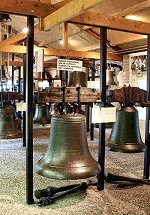
ASTEN - The National Carillon Museum in Asten was remounted and considerably enlarged in 2002. The overall exhibition space has more than doubled with the addition of two newly built wings. The collection was also substantially extended. The driving force behind this ambitious project was main curator Dr. André Lehr. The Municipality of Asten took charge of the enlargement of the building and the necessary fund raising. The renovated museum was formally reopened on Friday November 29, 2002.
HISTORY
On May 10, 1969, Mayor Jac. Rutten opened the Carillon Museum that was then located in the attic of the town hall of Asten. At that time the collection consisted of bells on loan from Royal Eijsbouts, a selection of archaeological and ethnographic clocks and bells owned by André Lehr, and some other objects like a playing drum. Because the museum was housed in the town hall, it could only be opened to the public during weekends.
In 1975 the Carillon Museum, together with the Natural Historical Museum, was moved to an old farm house, which was altered and expanded. The museum was reopened on June 13 by His Royal Highness Prince Bernhard. At that time, the curators of both museums were volunteers. In the beginning more than 80,000 tourists visited the museum annually. For the last few years the number of visitors is around 40,000 a year.
The city of Asten provides the building and also subsidizes the project. For the first time the museum now has a paid curator in the person of Rainer Schütte, who came from the "Glockenmuseum" in Gescher (Germany). After the completion of the enlargement in 2003 the main curator, Dr. André Lehr, will only be engaged in special projects. The museum has a workshop at its disposal.
COLLECTION
In recent years generous donations by various organizations and the Friends of the National Carillon Musuem were available to finance the expansion of the collection. The collection of the museum consists today of:
- Swinging bells from the 12th century, in particular bells from The Netherlands and Flanders.
- Chimes with keyboard and playing drums from the 16th century.
- A practice keyboard from the 18th century.
- Tower clocks from the 16th century.
- Two astronomical clocks.
- An archaeological collection of bells.
- Non-European bells from, among others, Africa, India, South-East Asia and Indonesia.
- A collection of books and manuscripts.
- Plaster casts from bells that were confiscated by the Germans in 1942.
Today the museum possesses some 4,000 artifacts and more than 12,000 books and manuscripts. From the outset, the intention was to create an interactive display of bells and clockworks. Visitors can ring and swing bells themselves or even play a small carillon from a keyboard. The enlargement of the museum comprises:
- An 18th-century bell-foundry.
- A time hall with two astronomical clocks and a time line.
- A bell tower with an automatic carillon of major-third bells.
- A campanological hall.
- A library.
- A considerably improved and secured archive.
BELL-FOUNDRY
A recreation of a real 18th-century bell-foundry has been set up in the museum. The exhibit looks so authentic that visitors are given the impression that the casters and founders have just left for lunch. In a realistic looking workshop one can see a series of bell models, a casting pit with moulds and a smelting- furnace. Moreover, all sorts of accessories and materials are displayed, like a clay bench, scales, loam and wax.
CAMPANOLOGICAL HALL
The fitting out of the new campanological hall will be completed in the spring of 2003, where the following topics will be featured:
- The design of a bell with a pair of compasses and ruler and the choice of the profile.
- The overtones of a bell and the instruments to measure these overtones.
- The visualization of the vibrations in a bell.
- The tuning of a bell on the lathe.
- The timbre of a bell.
- The computation of the profile of a bell with help of a computer.
- The major-third bell and the resulting major-third carillon.
- Bell investigators in the past and their scientific inheritance.
TIME LINE
A time line demonstrates the development of the bell from the beginning of the Middle Ages up to today. This illustrates how the profile of a bell evolved from a bee-hive shape to the present-day model with its most recent offspring - the major-third bell shaped as a cymbal. It also demonstrates how science assisted bell founders with improved measurement equipment.
LIBRARY
The museum possesses an extensive library with more than 12,000 books and manuscripts. The library is open to any bone fide researcher by appointment.
TOWER WITH BELLS
At the top of the newly built tower of the museum hang the major-third bells of the automatic carillon. This new bell type has been developed by the museum as an alternative for the first major-third bell model. The bell has the shape of a regular bell, but is far less in height. The 25 bells cast by Eijsbouts have the following notes: c2 – d2 – e2 – chromatic – d4. The diameter of the largest bell is 74 cm (weight 138 kg), the smallest 22 cm (weight 6 kg). During museum opening hours the automatic carillon plays every quarter of an hour. In the evening, bells and tower are floodlit.
